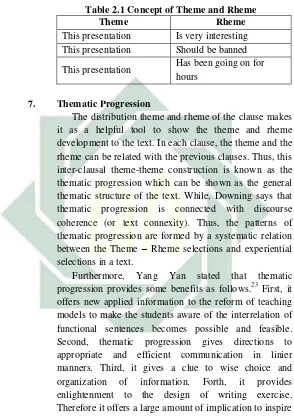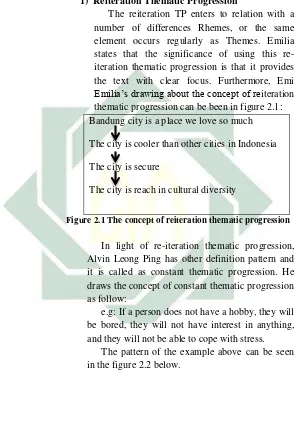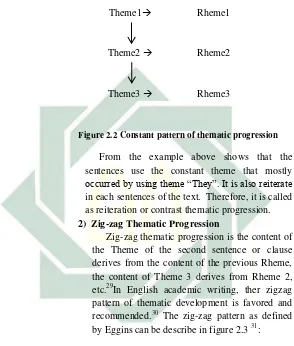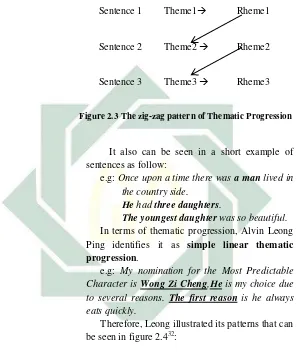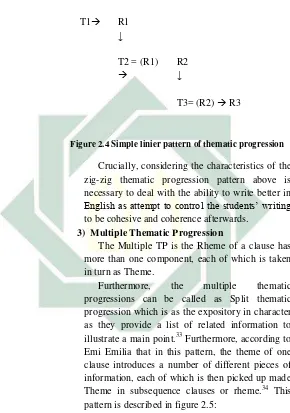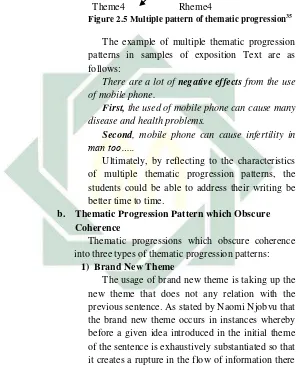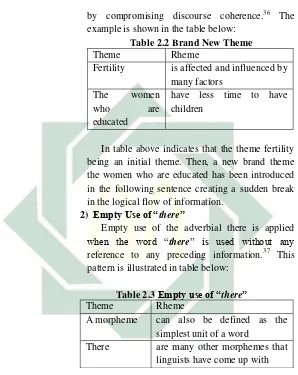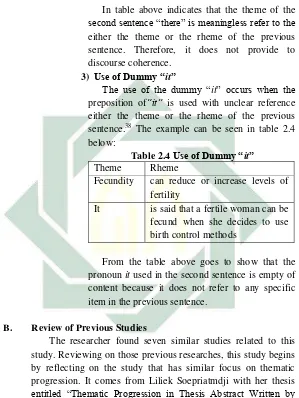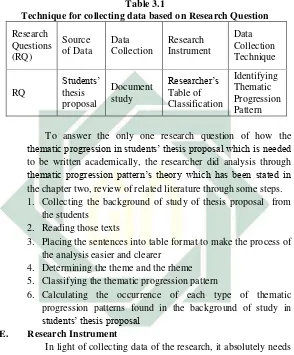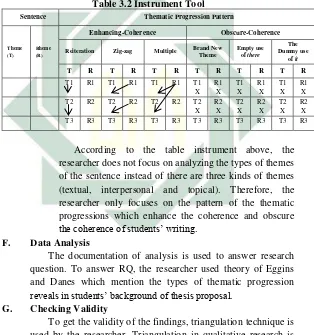THEMATIC PROGRESSION ANALYSIS IN
STUDENTS’ THESIS PROPOSAL OF
ENGLISH TEACHER EDUCATION
DEPARTMENT AT UIN SUNAN AMPEL
SURABAYA ACADEMIC YEAR 2016/2017
THESIS
Submitted in partial fulfillment of the requirement for
degree of Sarjana
Pendidikan (S.Pd) in Teaching English
By:
Naila Muroda
D05213021
ENGLISH TEACHER EDUCATION DEPARTMENT
FACULTY OF EDUCATION AND TEACHER
TRAINING
SUNAN AMPEL STATE ISLAMIC UNIVERSITY
SURABAYA
ABSTRACT
Muroda, Naila. 2017. Thematic Progression Analysis in Students’ Thesis Proposal of English Teacher Education Department at UIN Sunan Ampel Surabaya. A thesis. English Teacher Education Department, Faculty of Education and Teacher Training, Sunan Ampel State Islamic University. Surabaya. Advisors: Hilda Izzati Madjid, M.A. and Sigit Pramono Jati, M.Pd.
Key Words: Thematic Progression, thematic progression analysis, students’ thesis proposal.
ABSTRAK
Perkembangan tematik dianggap sebagai cara yang tepat untuk menghasilkan kohesif dan koherensi sebuah tulisan. Studi tentang perkembangan tematik telah menggambarkan penggunaannya sebagai alat untuk mengkarakterisasi tulisan pelajar bahasa kedua sebagai alat sukses atau kurang suksenya koherensi dalam sebuah tulisan pula. Penelitian ini diproyeksikan akan memberikan kontribusi penelitian tentang analisis linguistik dan wacana terutama pada perkembangan tematik dari paragraf pertama latar belakang studi dalam proposal tesis. Hal ini diharapkan bisa menjadi salah satu panduan bagi mahasiswa dan dosen tentang perkembangan tematik untuk membuat tulisan mahsiswa menjad lebih koheren dan kohesi. Penelitian ini dilakukan di Jurusan Pendidikan Bahasa Inggris di UIN Sunan Ampel Surabaya yang subjeknya adalah mahasiswa semester delapan yang telah mengambil matakuliah skripsi dan lulus ujian proposal. Penelitian ini menganalisis 12 latar belakang dalam sebuah skripsi dari semua siswa yang telah lulus ujian seminar proposal pada semester genap tahun akademik 2016/2017. Penelitian ini menggunakan metode kualitatif untuk mempresentasikan temuan tentang perkembangan tematik dalam latar belakang siswa bersamaan dengan pembahasan kata yang mengandung perkembangan tematik. Dua jenis pola yang diperiksa: pola yang meningkatkan koherensi dan yang mengaburkan koherensi. Yang pertama termasuk pola reiteration, zig-zag, dan multiple sementara pola yang mengaburkan koherensi termasuk adanya brand new theme, empty use of there, dan the use of dummy it. Temuan penelitian ini menunjukkan bahwa jenis pola tematik yang paling sering digunakan siswa untuk meningkatkan koherensi tulisan adalah 33 pola reiteration, diikuti oleh 23 pola zig-zag dan tidak adanya pola multiple. Kemudian, pola tematik yang paling sering digunakan siswa untuk mengaburkan koherensi tulisan adalah adanya brand new theme, kemudian diikuti oleh satu kali penggunaan empty use of there, dan tidak adanya penggunaan pola the use of dummy it
TABLE OF CONTENT
COVER
ADVISOR APROVAL SHEET ... i
APPROVAL SHEET ... ii
MOTTO ... iii
DEDICATION SHEET ... iv
ACKNOWLEDGEMENT ... v
PERNYATAAN KEASLIAN TULISAN ... vii
LEMBAR PERNYATAAN PERSETUJUAN PUBLIKASI ... viii
ABSTRACT ... ix
TABLE OF CONTENT ... x
LIST OF TABLE ... xiii
LIST OF FIGURE ... xiv
LIST OF CHART... xv
LIST OF APPENDICES ... xvi
LIST OF ABBREVIATION’S TERM ... xvii
CHAPTER I
:
INTRODUCTION A. Background of Study ... 1B. Research Question ... 7
C. Objective of the Study ... 7
xi
E. Scope and Limits of the Study ... 8
F. Definition of Key Terms ... 9
1. Thematic Progression ... 9
2. Thematic Progression Analysis ... 9
3. Theme ... 10
4. Rheme ... 10
5. Thesis Proposal ... 10
CHAPTER II
:
REVIEW OF RELATED LITERATURE A. Review of Related Literature ... 121. Writing ... 12
2. Discourse Analysis ... 14
3. Coherence ... 14
4. Cohesion ... 14
5. Theme ... 15
6. Rheme ... 16
7. Thematic Progression ... 17
B. Review of Previous Studies ... 26
CHAPTER III
:
RESEARCH METHOD A. Approach and Research Design ... 30B. Research Object ... 31
C. Data and Source of Data ... 31
1. Data ... 31
2. Source of Data ... 31
D. Data Collection Technique ... 31
E. Research Instrument ... 32
1. Main Instrument ... 32
2. Instrument Tool ... 33
F. Data Analysis... 33
G. Checking Validity ... 33
H. Research Stage ... 34
1. Preliminary Research ... 34
2. Research Design ... 34
3. Conduct the Research ... 35
xii
A. Research Finding ... 36
1. Students‟ Thematic Progressions ... 36
B. Discussion ... 59
1. Thematic Progression Pattern which Enhanced Coherence ... 61
2. Thematic Progression Pattern which Obscured Coherence ... 65
CHAPTER V
:
CONCLUSION AND SUGGESTION A. Conclusion ... 71B. Suggestion ... 72
1. Suggestion for lecturers... 72
2. Suggestion for further researcher ... 73
BIBLIOGRAPHY ... 74
APPENDICES ... 79
CHAPTER I INTRODUCTION
This chapter discusses the area of the study that will be covered in some headings; background of study, research question of the study, objective of the study, significance, scope and limitation, then definition of the key terms.
A. Background of Study
In educational issues, learning foreign language takes one of the important things. English as the foreign languages has become one of the compulsory subjects for Indonesian students from the junior high school level to university level. Thus, Indonesian students are called English as second language (EFL/ESL) learners. ESL learners may face difficulty in writing the foreign language itself.1According to Nunan, the difficulty is to produce a coherent, fluent, and extended piece of writing.2 Therefore, to solve the difficulty the learners need to have conscious effort and much practice in organization, language use and writing techniques.
According to Thuy Le and Raksangob, the ESL/EFL learners particularly are those who studying English for academic purposes and have found that writing is full of difficulty among other skills; also improving this skill requires hard work, much time and efforts.3Additionally, the ability to write in-depth academic essays is widely regarded as one of the hallmarks of a
higher education; students suffer from “writers' block”, awed by
1Zuhour Bani Younes – Fatima Salamh Albalawi. “Exploring the Most Common Types of
Writing Problems among English Language and Translation Major Sophomore Female
Students at Tabuk University”. Asian Journal of Basic and Applied Sciences.Vol. 3 No. 2, 2015
2Ibid
3Duong ThuyLe – RaksangobWijitsopon. “Using Theme-Rhemeto Analyze ESL/EFL
2
the fact that they have to write out their thoughts on a blank piece of paper.4 Moreover, Alonso and McCabe also pointed out that English learners are often wrote essays that consisted of sentences which did not seem to connect into a cohesive text and more attention should be paid to the progression of information in texts.5Therefore, those things define how difficult writing skill is.
Regarding those statements, Harmer stated that students have to follow various stages that any piece of writing goes through, such as pre-writing phases, editing, re-drafting, and finally producing a finished version of their work.6 Reflecting those three stages, Harmer argued that editing and re-drafting are even more important when we are writing in a foreign language than when we are writing in our first language.7 Additionally, Brown also stated that written products are often the results of thinking, drafting and revising procedures that require specialized skills, skills that not every speaker develops naturally.8It means that there are many things to be prepared before doing writing itself.
Reflecting the reason above, thematic progression (TP) consider as appropriate way to generate how cohesive and coherence the writing is. Studies have illustrated the usefulness of TP is that as a tool to characterize EFL/ESL writing as successful or less successful in terms of coherence.9 Furthermore, Not stated that TP is necessary for the construction of an
4Nada Salih Abdul Ridha. Theme and Rheme: Types and Problems in EFL University
Students' Written Texts. College of Education for Humanities. University of Basra, 96
5A. McCabe – S. Alonso. “Improving text flow in ESL learner compositions”. The Internet
TESL Journal, 9 (2). Available at http://iteslj.org/Articles/Alonso-ImprovingFlow.html 6Jeremy Harmer. The Practice of English Language Teaching. (London: Longman, 2007),
326
7Ibid
8H. Doughlas Brown.Language Assessment Principles and Classroom Practices. (New
York: Pearson Education, 2001), 335
9M. Bloor –T. Bloor. “Given and new information in the thematic progression of text: An
3
optimally coherent and grammatically cohesive structured text.10 TP is also a major aspect of the way the speakers construct their messages in a way which makes them fit smoothly into the unfolding language event.11 It indicates that without having TP, the text will look like no unity of ideas in it.
Furthermore, Wang claimed that the theory of TP was a valuable tool for teachers to diagnose writing difficulties and students should be taught how to arrange old and new information to help them improving their cohesion and coherence in writing.12 It shows that it is really necessary for lectures to include TP in their teaching for students to construct their writing in English in order to help the students organizing their writing thematically.
Thematic Progression consists of Theme and Rheme. Halliday stated that Theme is the point of departure for the message which the element of the speaker selects for grounding.13 It means that a Theme is a starting point of a sentence that can be the main information of the sentence itself. Thus, Theme needs Rheme to be the remainder of the message, the part in which the Theme is developed.14 It is noticed that as a message structure, a sentence is consisting of Theme and accompanied by a Rheme; which the structure is expressed as the Theme is put first. Herriman stated that the concept of Theme as point of departure of a single utterance (clause) to that explaining the inner connectivity of text, which is represented by thematic
10Elena Not.Implementation of the Thematic Progression and Realization Component.
(LRE Project 062-09, 1996), 4
11M. Bloor –T. Bloor. “Given and new information in the thematic progression of text: An
application to the teaching of academic writing”.Occasional Papers in Semantics Linguistics, 6 (1), 33-34
12L. Wang, “Theme and Rheme in the Thematic Organization of Text: Implications for
Teaching Academic Writing”. Asian EFL Journals. 9 (1), 164-176
13M.A.K Halliday. An Introduction to Functional Grammar (4th ed.). Revised by C.M.I.M
Matthiessen. (New York: Routledge, 2014), 83
14
4
progression.15 It goes to show that thematic progression can make a significant contribution to the coherence and cohesion of the text.
This research is conducted at thesis proposal writing in Faculty of English Teacher Education Department UIN Sunan Ampel Surabaya. Taking specifically thesis proposal as locus of this research was considered by two reasons. First, as the senior student of English Education Department UIN Sunan Ampel Surabaya who will graduate from university-life have to fulfill some requirements; one of it is about writing a thesis. Before the students have to take thesis proposal writing course, they had to pass some writing courses; those are paragraph writing, essay writing, and argumentative writing. Thus, it is as a part of compulsory subject in English Teacher Education Department at UIN Sunan Ampel Surabaya.16 Therefore, it tends to an institution-directed course that obligates the students to learn how to write a good thesis proposal.
Second, based on preliminary research that done through interviewing some students who had enrolled to thesis proposal writing at English Teacher Education Department UIN Sunan Ampel Surabaya shows that among all chapters of thesis writing, background of study in chapter one has mostly occurred as the most difficult part among others.17 That problem is forms of their difficulties in defining the background of study. It is the statements to show the important phenomena and indicates that it is really crucial to be conducted. Additionally, they assumed that the content of background will be the summary of the other chapters; which is needed more energy to read any references
15Wei Jing. “Theme and Thematic Progression in English Writing Teaching”. Journal of
Education and Practice. Vol.6 No.21, 2015
16http://siakad.uinsby.ac.id/akademik/siakad/index.php?page=list_kurikulum, accessed on
Thursday, October 27, 2016
17Preliminary research conducted on March, 13th 2017 to eight semester students of
5
dealing with those arguments. Furthermore, they feel worry about their statements; whether it is as good enough or not. Moreover, they are confused to connect between each paragraph to other paragraphs. Thus, they realize that the key success of thesis proposal is in the background. Therefore, they should write their background of study carefully. Indeed, it will be crucial to
analyze students‟ thesis proposal in English Teacher Education
Department of UIN Sunan Ampel Surabaya.
Then the objects of this research are the students‟ thesis
proposal written by eight semester students at English Teacher Education Department of UIN Sunan Ampel Surabaya. It is caused that the students are supposed to be able to write a thesis as the final exam to accomplish their bachelor degree before they graduate from the university. It may lead the students to be more challenging to make an understandable final thesis writing for the readers.
Despite of that, UIN Sunan Ampel Surabaya has also a vision, as an Islamic university that prepares excellent and
competitive students‟ outcome as international students.18 Furthermore, UIN Sunan Ampel Surabaya is ongoing process to be the World Class University after upgrading from Islamic State Institute several years ago. Becoming the World Class University, it requires preparing the students outcome as well. Automatically, it boosts the students to have the writing ability be better continuously. Ultimately, it goes to show that the thesis proposal course and university has mission to prepare students to be able to communicate and compete with other nations over the world.
There are seven researchers which deal with thematic progression. One researcher finds that the employment of constant thematic progression proved students experienced in
18Visi,Misi, dan Tagline UIN Sunan Ampel
Surabaya,(http://www.uinsby.ac.id/index.php/uinsa/visimisi, accessed on December 27th,
6
writing thesis abstract.19 One another researcher used Jingle Button technique to improve students‟ writing skill and learning motivation.20 Four other researchers focus on research done on the application of the types of themes (interpersonal, topical, and textual) in the texts. They used theme-rheme choices on DRET (Department Required Test), news item of presidential electoral campaign in the Jakarta Post, pre and post experimental theme
choices and in the text of Singapore secondary students‟
exposition text types.21 Last one, Hawes and Thomas in their research find that there is difference between Malaysian students level, advanced and intermediate level in using marked and unmark of topical themes.
However, this research has different focus from those previous researches. This research takes the thesis proposal written by the eight semester student of English Education Department at UIN Sunan Ampel Surabaya and it focuses on the thesis background which stated in the chapter one, while other previous studies conducted their researches to the thesis abstract, narrative text, exposition text, news item text, DRET reading text, and presidential electoral campaign in the Jakarta Post. While those two previous studies about the effectiveness technique using the thematic progression to improve students' writing skill and students‟ learning motivation through Jingle Button and constant thematic progression technique. Then those techniques are given to control and experimental class to measure
19Lilek Soepriatmadji. “Thematic Progression in Thesis Abstract written by English
students of FBIB UNISBANK Semarang”
20Farikah. “The Effectiveness of Thematic Progression Patterns with Jingle Button
Technique in Teaching Writing of Narrative Texts”. Arab World English Journal. Vol. 6 No. 1. 2015
21YANG Yan. “On The Patterns of Thematic Progression in The Argumentative Writing of
Non-English Majors”. US-China Foreign Language.Vol. 13, 2015., Chun Mei et al.
“Thematic Progression Pattern and the Text of the Department Required English Test”.
Department of Applied English at National Pingtung National Institute of Commerce.,
7
that effectiveness, while this research takes the new idea of investigating thematic progression occurred in the final period
students‟ writing. Indeed, this study has new focus which is
obviously different from the previous studies on investigating thematic progression of thesis proposal written by English Education Department students at UIN Sunan Ampel Surabaya. Knowing those reasons above, this research is important to examine the thematic progression of thesis proposal written by English Teacher Education Department students at UIN Sunan Ampel Surabaya. Essentially, this study will give some benefits for both current and upcoming teachers who teach writing as information to be aware of making cohesive and coherence writing to their students.
B. Research Question
In relation to the background of the study previously outlined above, the problem of the study can be formulated as this following question:
1. How is the thematic progression in students‟ thesis proposal of English Teacher Education Department at UIN Sunan Ampel Surabaya Academic Year 2016/2017?
C. Objective of the Study
To investigate the thematic progression in students‟ thesis
proposal of English Teacher Education Department at UIN Sunan Ampel Surabaya Academic Year 2016/2017.
D. Significance of the Study
8
construct a message, and the challenge that faced by all writers is to get the message right. Therefore, it assists the English teacher to make the students aware of the message components of language (ie. theme-rheme and thematic progressions) and how they can be implicated at the sentence and text level can go some
way to ease this struggle. Importantly, it guides the student‟
attention to the message structure of their text and enhances their awareness of truly matters in writing, which is getting the message right. Therefore, the researcher also hopes to be able to share the information and the result of this study to other teachers in order to be the reference for them to conduct the further research dealing with thematic progression.
E. Scope and Limits of the Study
This study confines its self to the study of thematic progression in thesis proposal writing. This research does not observe overall of the thesis proposal. The researcher determines the scope of this study on the first paragraph of background of study in the thesis proposal. As stated by William and Collomb that one first paragraph of background of study is first impressions matter. The reader will be more inclined to read a paper and consider a position if the initial paragraph is clear, organized, and engaging and for the writer, a carefully crafted first paragraph acts as a springboard, establishing the order and direction for the entire paper.22 Hence, it challenges the students to write well since the one first paragraph of their background of study. Moreover, the focus of this study is on investigating thematic progression in thesis proposal which have been examined during the even semester of academic year 2016/2017specifically starting from February 2017 to March 2017. Twenty one students had been followed in thesis proposal examination, and then only twelve students are in the eighth
22Joseph M. Williams & Gregory G. Colomb. The Craft of Argument; Introduction and
9
semester, while the other nine students are from tenth semester students. The researcher does not analyze the other nine backgrounds of study due to the researcher got some difficulties to get their text. Therefore, the researcher only uses twelve
backgrounds of study of students‟ thesis proposal.
F. Definition of Key Terms
In case of different perspectives of the readers, the researcher shows the definition of important terms used in this study as an attempt to avoid misinterpreting among readers toward the concept of this study. In this early discussion, the researcher finds out the term that should be recognized first by the readers as follows:
1. Thematic Progression
Thematic Progression is the way the themes interact each other with the rhemes in order to provide continuity in discourse and to organize the text.23 In this study the
thematic progression is used to analyze the student‟ thesis
proposal in order to know more the students‟ cohesiveness of their writing, help them become aware of how information and ideas should flow a text so that it could be easily understood by the readers.
2. Thematic Progression Analysis
Analysis is to ask what that something means and it is a kind of thinking you will most often be asked to do in your work.24 Furthermore according to max-weber that analysis is a detailed examination of anything complex in order to understand its nature.25 Therefore, thematic progression analysis in this study means the way of
23Wei Jing. “Theme and Thematic Progression in English Writing Teaching”. Journal of
Education and Practice. Vol. 5 No. 21, 2015
24http://www.indiana.edu/~bestsell/1.pdf (accessed on Monday, 7th August 2017) 25https://www.merriam-webster.com/dictionary/analysis, (accessed on Monday, 7th August
10
analyzing theme and rheme in detail though the pattern of thematic progression. Thus, the backgrounds of study in thesis proposal of the students are analyzed through the pattern of thematic progression to know the coherence and cohesion of the texts.
3. Theme
According to Halliday, theme in English is a position-bound, clause-initial element and whatever is selected as theme is always positioned first in the clause.26 Indeed,
based on Halliday‟s theory theme meant in this study is
first information in each clause of Thesis Proposal of eight semester students of UIN Sunan Ampel Surabaya.
4. Rheme
Rheme is simply defined part of the assembly new information that the text offers.27Regarding Cummings‟ theory, rheme in this study is defined as what you are saying about conventionally comment used on the theme. It is the rest of the clause or it is the supporting information of the theme that occurred in seminar proposal thesis background of eight semester students of English Teacher Education Department of UIN Sunan Ampel Surabaya.
5. Thesis Proposal
Thesis proposal in this case is focuses on background of study in the chapter one. Background in thesis is a state of art review of the field of study, including current developments, controversies and breakthroughs, previous research and relevant background theory, what Pis being researched and why, justification for the choice of data,
26M.A.K Halliday,& C.M.I.M Matthiessen. An Introduction to Functional Grammar (3rd
ed). (London: Arnold, 2004), p. 65
27M. Cummings. The Role of Theme and Rheme in Contrasting Methods of organization of
11
and importance of the project for the field of study.28 In this study, the researcher defines the definition of thesis background as the phenomena happened around the
researcher‟s society. The background of study here means
as an opening part of the chapter one in thesis proposal written by eight semester student of English Teacher Education Department at UIN Sunan Ampel Surabaya.
28Brian Paltridge. Writing the Background Chapters of Your Thesis. (The University of
CHAPTER II
REVIEW OF RELATED LITERATURE
A. Review of Related Literature
In this chapter, the researcher explicates several theories through reviewing some literatures related to this study. This theoretical construct deals with seven main areas which are writing, discourse analysis, coherence, cohesion, theme, rheme, and thematic progression.
1. Writing
There are some definitions of writing made by different linguist. Some are explained as follows. Writing is one of the main parts of education and it is necessary both for students and for employees of all business sectors.1 Moreover, the present study emphasis on the process of writing has rightly heightened awareness of the complex consideration facing any writer; it is still the end product, the finished text, which bears testament to how well the writer has juggled these constraints.2 Rumisek and Zemach state that those processes consist of pre-writing, drafting, reviewing, revising, and rewriting.
Reflecting Rumisek and Zemach‟s statement indicates that
students can be shown the different stages in the production of a piece of writing and be encouraged to discover what works best for them.
Thus the ability to write effectively is becoming increasingly important in our global community, and instruction in writing is thus assuming an increasing role
1Natilene Bowker. “Academic Writing: A Guide to Tertiary Level Writing”. (New
Zealand: Massey University, 2007)
2
Alvin Leong Ping. “Developing the Message: Thematic Progression and Student
13
in both second and foreign language education.3 It goes to show that writing is a skill that is required in many contexts throughout life; for instance you can write an email to a friend, reflect on what happened during the day in your personal diary or write essay for your homework.
However, according to Alvin Leong the thing means as writing is that it has to do with the notion of form itself. He means by form of it is as the typical components or segmentation of particular text type. For instance, an expository or argumentative writing text, typically contain
a thesis statement of the writer‟s position and arguments
in support of that position. While a personal narrative contains segments that are expected of that text type such as orientation, complication, evaluation, resolution, and coda. This reveals to suggest that students who are familiar with the typical segmentations of a range of text types are able to write in a way that is coherent and easy to comprehend. In term of the segmentation of text type, as cited by Harvard Education website that there are three simple concepts to keep in mind when writing a background of study in thesis as follows; engage the readers with broader themes and topics that illustrate your concepts, questions, and theory and demonstrate your knowledge and passion.4 Thus, background of study focuses on giving the reader the relevant facts about the topic so that the readers understand the material that the researcher is writing about and how it links to the research question. It means this part provides the general context, but must direct the readers' attention to the empirical details through which the research topic and question are lived, made relevant, and important to be studied.
3
Sara Cushing Weigle. “Assessing Writing”. (Cambridge: Cambridge University, 2002). 1 4
14
2. Discourse Analysis
This is qualitative approach that is used to analyze written, spoken or signed language.5 Furthermore, Stubbs defined the term discourse analysis to the linguistic analysis of naturally occurring, connected spoken or written discourse.6In other words, discourse analysis is the analysis of language in use.
3. Coherence
Coherence is achieved when sentences and ideas are connected and flow together smoothly and it allows the reader to move easily throughout the essay from one idea to the next, from one sentence to the next, and from one paragraph to the next.7 Another definition of coherence is about three things.8 The first is about the conditional (the sentences that are related to the context). Second is about the situational that the readers can identify the situation. Third is about generic which included the readers to be able to identify the types of the text, ideas that are organized in particular ways; time, space, and order of importance (general-particular, cause-effect, and comparison-contrast).
4. Cohesion
Cohesion is that the meaning of items in a text is interrelated.9 Achieved through the use of pronouns (he, she, they, we, I), reference words (this, those, such), lexical repetition (words are repeated), and logical markers (first, second, nest, then). Additionally, cohesion means as organizational devices like headingsthat help to link sentences, paragraphs and sections coherently in
5
Ibid
6
M. Stubbs. Discourse Analysis.( London: Blackwell, 1983)
7
Jayetta Slawson, et al. Coherence. (Southeastern Writing Center, 2010), 42-45
8
Mrs. Siti Asmiyah‟s PPT on Paragraph writing course of second semester student 9
15
longer, complex writing projects.10 Furthermore, Dorchies stated there are four main components of cohesion which are relevance, order, linking words, and repetition of key words.11 Thus, without cohesion a written work can seem choppy and may not flow well.
5. Theme
Theme is the theory of functional grammar which is realization of the textual metafunction of language as proposed by Halliday.12 In the Hallidyan framework, theme and rheme form the message structure of the clause.13According to Martin, the theme is concerned with the organization of information within individual clauses, and through this, with the organization a larger text.14
Furthermore, the theme is the starting point of a message, which the sentence is about.15 Additionally, Firbas defines theme under two concepts: (1) as the starting-point of the sentence – which is known or at least obvious in the given situation and from which the speaker proceeds, and (2) as the foundation of the sentence – something being spoken about in the sentence.16 The first position in a clause means as textual meanings because it signposts the development of the text. Furthermore, it frequently serves to present given information which has already been mentioned somewhere in the text, or
10
Greg Dorchies.Cohesion. (www.clarkson.edu/writingcenter/docs/cohesion.pdf, accessed on Friday, 14th July 2017)
11
Ibid
12
Emi Emilia. Introducing Functional Grammar. (Bandung: Dunia Pustaka Jay, 2014), 225
13
M.A.K Halliday & C.M.I.M Matthiessen.An Introduction to Functional Grammar (3rded). (London: Arnold, 2004), 64
14
J. R. Martin. Analysis genre: Functional Parameters. In F. Christie & J.R. Martin. (Eds). Genre and Institution. (London: Continum), p.21
15
M.A.K Halliday. An Introduction to Functional Grammar (4th ed.). Revised by C.M.I.M
Matthiessen. (New York: Routledge, 2014)
16
16
understood as a common knowledge from the particular context.17 Additionally, Coffin and Hewings stated that Theme in English can be thought of as that element in a clause or larger unit of text which come first.18 It means that the element which comes first in the clause can be called as a Theme. Since the Theme is a first part of the clause, so there is another thing followed the Theme itself. It is called as a Rheme.
6. Rheme
Cummings stated that Rheme is a part of the assembly of the new information that the text offer.19 According to
Cummings‟s definition it indicates that Rheme is what the
speaker says about and expressing something new or something unknown from the previous context. Furthermore, Wei Jing stated that Rheme is the reminder of the message in a clause in which the Theme is developed, which means the Rheme typically contains unfamiliar or new information.20 Furthermore, rheme is as the development of theme and it is always comes after theme.21 It indicates that Rheme is something that giving supporting idea of the theme. Hence, Table 2.1 is listed the clause-initial of theme and rheme.22
17
Duong ThuyLe – Raksangob Wijitsopon. “Using Theme-Rhemeto Analyze ESL/EFL
Learners‟ Academic Writing”. 18
C. Coffin & A. Hewings. “IELTS as preparation for tertiary writing: distinctive interpersonal and textual strategies”. In L.J. Ravelli & R. A. Ellis.Analyzing academic
writing. (London: Continuum. 2004), p.136
19
M. Cummings. The Role of Theme and Rheme in Contrasting Methods of organization of texts. In Butcler, C. (Ed.) Dynamics of Language Use: Functional and Contrastive Perspective (Amsterdam/Philadelphia: John Benjamins, 2003), 133
20
Wei Jing. “Theme and Thematic Progression in English Writing Teaching”. Journal of Education and Practice. Vol. 2, No. 21, 2015
21
M.A.K Halliday & C.M.I.M Matthiessen. An Introduction to Functional Grammar (3rded). (London: Arnold, 2004), 65
22
Alvin Leong Ping. “Developing the Message: Thematic Progression and Student
17
Table 2.1 Concept of Theme and Rheme
Theme Rheme
This presentation Is very interesting This presentation Should be banned
This presentation Has been going on for hours
7. Thematic Progression
The distribution theme and rheme of the clause makes it as a helpful tool to show the theme and rheme development to the text. In each clause, the theme and the rheme can be related with the previous clauses. Thus, this inter-clausal theme-theme construction is known as the thematic progression which can be shown as the general thematic structure of the text. While, Downing says that thematic progression is connected with discourse coherence (or text connexity). Thus, the patterns of thematic progression are formed by a systematic relation between the Theme – Rheme selections and experiential selections in a text.
Furthermore, Yang Yan stated that thematic progression provides some benefits as follows.23 First, it offers new applied information to the reform of teaching models to make the students aware of the interrelation of functional sentences becomes possible and feasible. Second, thematic progression gives directions to appropriate and efficient communication in linier manners. Third, it gives a clue to wise choice and organization of information. Forth, it provides enlightenment to the design of writing exercise. Therefore it offers a large amount of implication to inspire
23
YANG Yan. “On the patterns of thematic progression in the Argumentative Writing of
18
the instructor devoted to the language teaching. Thus, thematic progression patterns presented the key concepts relating to two categories of thematic progression patterns; those which enhance coherence and those which obscure it.24 As postulated by Eggins, the thematic progressions which enhance coherence include reiteration progression pattern, zig-zag progression pattern, and multiple progressions pattern.
However, besides those three types of thematic progression pattern proposed by Eggins which have been explained, Danes propounded one more type of thematic progression pattern.25 It is a derived theme pattern. Derived theme is a situation where the topics of each sentence are individually different; the fact is that it uses the same overriding Theme. The example of derived theme is shown below.
Ecuador is situated on the equator in the northwest of South America (1). The economy is based on oil and agricultural products (2). More oil is produced in Ecuador than any other South American country except Venezuela (3). Bananas, coffee, and cocoa are grown there (4). The people are mostly of Indian origin (5). Several Indian languages are spoken there (6). The currency is called the Sucre (7).
The example above shows that the second theme (the economy), the third theme (More oil), the fourth theme (Bananas, coffee, and cocoa), the fifth theme (Several
24
Naomi Njobvu. “The Relationship Between Thematic Progression and English Discourse Coherence: An Investigation Based on some University of Zamia Students‟ Writing Discourse”. Lusuka. 2010, 11
25
19
Indian languages), and the sixth theme (The currency) actually give some information concerning Ecuador. Somehow, reflecting the example above, Dubois points out that those themes would appear to be totally unrelated. However, at the same time, it must be noted that Dubois suggested as reiteration theme rather than as derived theme.
Furthermore, McCabe state that the notion of derived
theme can be thought of more indirect to a „lay‟ reader;
thus one would not be expected to find it in texts where the readers do not share the same degree of knowledge shared by writers and readers of very specialized texts.26 Thus, writers need to infuse their texts with clearer links of meaning, thereby producing links which are closer to reiteration theme or simple linear theme rather than to derived theme. Thus, the derived theme pattern is difficult to judge because there is still a debate on whether derived theme is one type of thematic progression or not.
Bloor & Bloor stated that the thematic progression patterns which obscure coherence include brand new theme, empty rheme, and empty use of the adverbial
“there”.27 While Danes added the use of dummy itis also as one of the misusing of the thematic progression pattern.28 Therefore, there are three types of thematic progression which obscure the coherence.
a. Thematic Progression Pattern which Enhance
Coherence
Thematic progressions which enhance coherence into three types of thematic progression patterns:
26
Ibid
27
Nada Salih Abdul Ridha. “Theme and Rheme: Types and Problems in EFL University Students' Written Texts”.College of Education for Humanities. University of Basra, 104-105
28
20
1) Reiteration Thematic Progression
The reiteration TP enters to relation with a number of differences Rhemes, or the same element occurs regularly as Themes. Emilia states that the significance of using this re-iteration thematic progression is that it provides the text with clear focus. Furthermore, Emi
Emilia‟s drawing about the concept of reiteration thematic progression can be been in figure 2.1: Bandung city is a place we love so much
The city is cooler than other cities in Indonesia
The city is secure
[image:30.420.69.364.76.502.2]The city is reach in cultural diversity
Figure 2.1 The concept of reiteration thematic progression
In light of re-iteration thematic progression, Alvin Leong Ping has other definition pattern and it is called as constant thematic progression. He draws the concept of constant thematic progression as follow:
e.g: If a person does not have a hobby, they will be bored, they will not have interest in anything, and they will not be able to cope with stress.
21
Theme1 Rheme1
Theme2 Rheme2
[image:31.420.71.365.77.423.2]Theme3 Rheme3
Figure 2.2 Constant pattern of thematic progression
From the example above shows that the sentences use the constant theme that mostly
occurred by using theme “They”. It is also reiterate
in each sentences of the text. Therefore, it is called as reiteration or contrast thematic progression.
2) Zig-zag Thematic Progression
Zig-zag thematic progression is the content of the Theme of the second sentence or clause derives from the content of the previous Rheme, the content of Theme 3 derives from Rheme 2, etc.29In English academic writing, ther zigzag pattern of thematic development is favored and recommended.30 The zig-zag pattern as defined by Eggins can be describe in figure 2.3 31:
29
Emi Emilia. Introducing Functional Grammar. (Bandung: Dunia Pustaka Jay, 2014), 241
30
P. H. Fries. Themes, Methods of Development, and Text. In R. Hasan & P. H. Fries. (Eds.). On Subject and Theme. A Discourse Functional Perspective (Amsterdam: John Benjamins. B. V)
31
22
Sentence 1 Theme1 Rheme1
Sentence 2 Theme2 Rheme2
[image:32.420.70.367.79.442.2]Sentence 3 Theme3 Rheme3
Figure 2.3 The zig-zag pattern of Thematic Progression
It also can be seen in a short example of sentences as follow:
e.g: Once upon a time there was a man lived in the country side.
He had three daughters.
The youngest daughter was so beautiful. In terms of thematic progression, Alvin Leong Ping identifies it as simple linear thematic progression.
e.g: My nomination for the Most Predictable Character is Wong Zi Cheng,He is my choice due to several reasons. The first reason is he always eats quickly.
Therefore, Leong illustrated its patterns that can be seen in figure 2.432:
32
23
T1 R1
↓
T2 = (R1)
R2 ↓
[image:33.420.72.362.68.481.2]T3= (R2) R3
Figure 2.4 Simple linier pattern of thematic progression
Crucially, considering the characteristics of the zig-zig thematic progression pattern above is necessary to deal with the ability to write better in
English as attempt to control the students‟ writing
to be cohesive and coherence afterwards.
3) Multiple Thematic Progression
The Multiple TP is the Rheme of a clause has more than one component, each of which is taken in turn as Theme.
Furthermore, the multiple thematic progressions can be called as Split thematic progression which is as the expository in character as they provide a list of related information to illustrate a main point.33 Furthermore, according to Emi Emilia that in this pattern, the theme of one clause introduces a number of different pieces of information, each of which is then picked up made Theme in subsequence clauses or rheme.34 This pattern is described in figure 2.5:
33
Wei Jing. “Theme and Thematic Progression in English Writing Teaching”. Journal of Education and Practice. Vol. 6 No. 21, 2015
34
24
Theme1 Rheme1
Theme2 Rheme2
Theme3 Rheme3
[image:34.420.68.367.110.488.2]Theme4 Rheme4
Figure 2.5 Multiple pattern of thematic progression35
The example of multiple thematic progression patterns in samples of exposition Text are as follows:
There are a lot of negative effects from the use of mobile phone.
First, the used of mobile phone can cause many disease and health problems.
Second, mobile phone can cause infertility in man too…..
Ultimately, by reflecting to the characteristics of multiple thematic progression patterns, the students could be able to address their writing be better time to time.
b. Thematic Progression Pattern which Obscure
Coherence
Thematic progressions which obscure coherence into three types of thematic progression patterns:
1) Brand New Theme
The usage of brand new theme is taking up the new theme that does not any relation with the previous sentence. As stated by Naomi Njobvu that the brand new theme occurs in instances whereby before a given idea introduced in the initial theme of the sentence is exhaustively substantiated so that it creates a rupture in the flow of information there
35
25
[image:35.420.69.367.61.436.2]by compromising discourse coherence.36 The example is shown in the table below:
Table 2.2 Brand New Theme
Theme Rheme
Fertility is affected and influenced by many factors
The women
who are
educated
have less time to have children
In table above indicates that the theme fertility being an initial theme. Then, a new brand theme the women who are educated has been introduced in the following sentence creating a sudden break in the logical flow of information.
2) Empty Use of “there”
Empty use of the adverbial there is applied
when the word “there” is used without any reference to any preceding information.37 This pattern is illustrated in table below:
Table 2.3 Empty use of “there”
Theme Rheme
A morpheme can also be defined as the simplest unit of a word
There are many other morphemes that linguists have come up with
36
Naomi Njobvu. “The Relationship Between Thematic Progression and English Discourse
Coherence: An Investigation Based on some University of Zamia Students‟ Writing
Discourse”. Lusuka. 2010, 17
37
Naomi Njobvu. “The Relationship Between Thematic Progression and English Discourse Coherence: An Investigation Based on some University of Zamia Students‟ Writing
26
In table above indicates that the theme of the
second sentence “there” is meaningless refer to the
either the theme or the rheme of the previous sentence. Therefore, it does not provide to discourse coherence.
3) Use of Dummy “it”
[image:36.420.68.367.67.465.2]The use of the dummy “it” occurs when the preposition of“it” is used with unclear reference either the theme or the rheme of the previous sentence.38 The example can be seen in table 2.4 below:
Table 2.4 Use of Dummy “it” Theme Rheme
Fecundity can reduce or increase levels of fertility
It is said that a fertile woman can be fecund when she decides to use birth control methods
From the table above goes to show that the pronoun it used in the second sentence is empty of content because it does not refer to any specific item in the previous sentence.
B. Review of Previous Studies
The researcher found seven similar studies related to this study. Reviewing on those previous researches, this study begins by reflecting on the study that has similar focus on thematic progression. It comes from Liliek Soepriatmdji with her thesis
entitled “Thematic Progression in Thesis Abstract Written by English Students of FBIB UNISBANK Semarang”. The
38
27
researcher finds that English students of FBIB could prove their experience in writing abstract with respect to the employment of thematic progression. Her research only focuses on analyzing the constant thematic progression pattern which is characterized as the most tedious pattern in developing a paragraph. However, this study is more specific in investigating all types of thematic progression toward the background study of thesis proposal.
Another past research comes from Farikha, with the title
“The Effectiveness of Thematic Progression (TP) Pattern with
Jingle Button (JB) Technique in Teaching Writing Narrative
Text”. The result shows that implementing TP-JB technique can
improve the students‟ writing skill of narrative text. The finding of this research also reveals that the implementation of this
technique also improves the students‟ learning motivation in
joining teaching-learning activities of writing class. The good point applied in this research is that there are 98.50% of the students have good motivation after implementing of TP-JB technique. Ultimately, the research conducted by Farikah has a
quiet difference between this study. Farikha‟s study concerns on
comparative study of effectiveness using thematic progression by jingle button technique. While this study focuses on a descriptive study in investigating the thematic progression occurred in thesis proposal written by ETED of UIN Sunan Ampel Surabaya.
The research by YANG Yan, with the title, “On the Pattern of Thematic Progression in the Argumentation Writing of
Non-English Majors” reveals the finding that the application of “Theme-Based Approach” in improving non-English majors‟ writing ability. The result shows that by implementing those theme-rheme to the experimental class has positive impact on the
improvement of students‟ writing ability and high grades have
28
theme-rheme to experimental class, and supporting sentence to the control class. The differences compared to this recent study shows that the research conducted by YANG Yan specifically testifies the implemented technique, while this study focuses on
analyzing the thematic progression on students‟ thesis proposal
without including some technique.
A study comes from Chun Mei, with the title, “Thematic Progression Patterns and the Texts of the Department Required
English Text”. This study analyzes the themes choices of
Department Required English Test (DRET). The DRET is one of English Proficiency test in enrolling to high secondary school. The text is gotten from the reading passage of the text. The result of this study is the topical themes of unmarked theme type distribute the most. The difference compared to this study is this upcoming study does not analyze the theme types but it prefers to the thematic progression occur in thesis proposal.
A research from Izzatu Ni‟mah with the title “Thematic Organization on News Item” focuses on the system of themes
which consist of topical, interpersonal, and textual theme from the Jakarta Post website of presidential electoral campaign. The researcher found that there is no greater difference of the use of those themes done by the journalist to give the factual information to the readers. The difference is that this current study analyzed the theme types done by the journalist in general without discussing more about the thematic progression.
29
specifically on the types of themes and comparative study towards the weak and good essays.
A study from Hawes and Thomas looked at 100 essays written by Malaysian tertiary students (Eighty of the hundred essays were produced while on courses at The British Council Language Centre, Penang and twenty at the nearby Science University of Malaysia by students studying for a degree in English Language and Literature) from lower intermediate level to advanced level.39These essays were analyzed for the theme choices. Hawes and Thomas argued that theme can be used to give different appearance in the text. The use of marked themes in the essays also revealed significant results. Advanced writers used more marked themes (20.8% of all themes) than intermediate writers (11%).
Finally, the researcher concludes that those all previous studies considerably have similarities and differences with this study. Somehow, those literatures encourage this study as the groundwork. In case of making this study different with those previous studies, the researcher reveals that the different focus of this study is on analyzing the thematic progression occurred in
student‟ thesis proposal background of study written by eight
semester students of ETED at UIN Sunan Ampel Surabaya.
39
Hawes, T., & Thomas, S. “Problems of thematisation in student writing”. RELCJournal,
CHAPTER III RESEARCH METHOD
This part study deals with research methodology which is design as technique to collect and analyze the data.
A. Approach and Research Design
This research is typically designed as qualitative descriptive study. A qualitative research leads the researchers to understand the phenomenon of the research subjects such as behavior, perception, motivation, etc. through descriptive approach in form of words.1Furthermore, it holds a valuable place within education, because in contrast to laboratory experiments, the human nature of educational research is critical to the result.2
The approach of descriptive study research is trying to describe reality according to a systematic approach rigorously followed; it is based on theoretical considerations and is dependent on the objective of the study as well.3It goes to show that he emphasis is then not so much on generalizing, but on generating knowledge and on building hypotheses. Therefore type of qualitative descriptive study with descriptive approach is used in this research with aims to analyze the thematic progression used by the eight semester students of English Teacher Education Department at UIN Sunan Ampel Surabaya in writing a thesis proposal.
The data are collected through document study. Thus, some thesis proposals are chosen based on those who had followed
1Lexy Jmoleong. Metodologi Penelitian Kualitatif. (Bandung : PT Remaja Rosdakarya,
2005), 6
2Nancy Nelson Knupfer and Hilary McLellan. Descriptive Research Methodologies. 3Wendelien Lans, Theo Van Der Voordt. “Descriptive Research”. Delft: DUP Science.
31
proposal examination during the even semester of eighth
semester students‟ academic year 2016/2017.
So, there will be twelve students‟ background of studies in
thesis proposal that will be analyzed by the researcher.
B. Research Object
The research object of this research is background of study of thesis proposal written by the students of English Teacher Education Department. The research object took specifically in academic year of 2016/2017.
C. Data and Source of Data
1. Data
The data of this study is the data from the students‟
thesis proposal writing. So, the researcher gets the
students‟ thesis proposal from the students directly. Then, after getting the file, the researcher would conduct analyzing them by breaking down through some sentences and then identifying the thematic progression occurred in the text.
2. Source of Data
The source of data is from students‟ thesis proposal writing at English Teacher Education Department of UIN Sunan Ampel Surabaya. The data is attained by asking
copy of students‟ thesis proposal to the students directly.
After getting the copies of the writing, the researcher
starts to analyze the thematic progression in students‟
background of study in their thesis proposal.
D. Data Collection Technique
In this study, data were collected by techniques of document
study. The researcher asked the documents of students‟
background of study in thesis proposal of English Teacher Education Department. Then, the researcher analyzes the
thematic progression in students‟ background of study to know
32
Table 3.1
Technique for collecting data based on Research Question Research
Questions (RQ)
Source of Data
Data Collection
Research Instrument
Data Collection Technique
RQ
Students‟
thesis proposal
Document study
Researcher‟s
Table of Classification
Identifying Thematic Progression Pattern
To answer the only one research question of how the
thematic progression in students‟ thesis proposal which is needed
to be written academically, the researcher did analysis through
thematic progression pattern‟s theory which has been stated in
the chapter two, review of related literature through some steps. 1. Collecting the background of study of thesis proposal from
the students 2. Reading those texts
3. Placing the sentences into table format to make the process of the analysis easier and clearer
4. Determining the theme and the rheme 5. Classifying the thematic progression pattern
6. Calculating the occurrence of each type of thematic progression patterns found in the background of study in
students‟ thesis proposal
E. Research Instrument
In light of collecting data of the research, it absolutely needs the instrument. Thus, the researcher designed the instruments for investigating research question in one technique included thesis proposal background of study analysis.
1. Main Instrument
33
work done by students of English Teacher Education Department at UIN Sunan Ampel Surabaya.
2. Instrument Tool
The particular tool is needed to analyze the result of
thematic progression occurred in students‟ background of
[image:43.420.69.383.171.506.2]study in thesis proposal writing. In doing the research, the researcher makes the table 3.2 as below:
Table 3.2 Instrument Tool
Sentence Thematic Progression Pattern
Theme (T)
Rheme (R)
Enhancing-Coherence Obscure-Coherence
Reiteration Zig-zag Multiple Brand New
Theme Empty use of there The Dummy use of it
T R T R T R T R T R T R
T1 R1 T1 R1 T1 R1 T1
X R1 X T1 X R1 X T1 X R1 X
T2 R2 T2 R2 T2 R2 T2
X R2 X T2 X R2 X T2 X R2 X
T3 R3 T3 R3 T3 R3 T3 R3 T3 R3 T3 R3
According to the table instrument above, the researcher does not focus on analyzing the types of themes of the sentence instead of there are three kinds of themes (textual, interpersonal and topical). Therefore, the researcher only focuses on the pattern of the thematic progressions which enhance the coherence and obscure
the coherence of students‟ writing.
F. Data Analysis
The documentation of analysis is used to answer research question. To answer RQ, the researcher used theory of Eggins and Danes which mention the types of thematic progression
reveals in students‟ background of thesis proposal.
G. Checking Validity
34
rich, robust, comprehensive, and well-developed.4 Thus, the function of checking validity is for making sure of the absolute this research. As explained by Creswell that using a single method can never adequately shed light on a phenomenon; therefore multiple methods or techniques are needed in order to get deeper understanding.5
Further, Denzin divided triangulation into four types. They are theoretical triangulation, triangulation of source, analyst triangulation, and methodological triangulation.6 In this research, the researcher also validated the findings using theory triangulation; as several thematic progressions pattern theories were regarded. Moreover, analyst triangulation was applied as well through the researcher and the expert lecturers, including the advisors have warranted the findings too.
H. Research Stage
The researcher conducted this study with some stages. The detail stages are:
1. Preliminary Research
The researcher had a mini research of dealing with
2016 odd semester students‟ writing coherently and
cohesively. Due to the semester curriculum that obligates the students to write their proposal, the researcher
analyzed the students‟ thesis proposal to know the way the
students maintain their writing in it.
2. Research Design
The researcher chose the research design for this research after finding out the title and the theme of this research. Furthermore, the research question is used to decide the research design.
4MJ Angen. Qualitative Health Research. Vol. 10, 2000, p. 379,
5John W. Creswell. Qualitative Inquiry and Research Design Choosing Among Five
Traditions (Thousand Oaks, CA: SAGE Publications Inc., 1998), p. 57
6
35
3. Conduct the Research
a. Collecting Data
At the first, the researcher asked the dean of academic staff of English Teacher Education Department to know the amount of students who have followed thesis proposal examination. Then, the researcher decided to take and collect the data from
students‟ thesis proposal and start to analyze it.
b. Analyzing Data
After obtaining the data from the students‟
background of study in thesis proposal, the researcher directly analyzed the data in attempt to get the answer of the research question as stated in data analysis techniques.
c. Concluding Data
CHAPTER IV RESEARCH FINDING
This chapter presents and analyzes the data which have been
collected during the research. The data were taken from students‟ thesis
proposal examination during the even semester of academic year 2016/2017 at English Teacher Education Departments of UIN Sunan Ampel Surabaya. The researcher obtained the data through the document.
A. Research Finding
As previously stated in the chapter one, this study wants to know how the way the students maintain their writing in background of study in their thesis proposal. To know the
answer, the researcher analyzes the data of thirteen students‟
work using thematic progression. There are several thematic
progressions in students‟ background of study of thesis proposal. The findings of the research are dealing with the thematic
progression in students‟ background of study of thesis proposal
based on the theories explained in the chapter 2, related review literatures. The following discussion reveals into students work
and the researcher‟s analyzing. The Table shows some parts of students‟ background of study in their thesis proposal, while below the table is the researcher‟s analyzing.
1. Students’ Thematic Progressions
To write the first paragraph of background of study in thesis proposal, some students maintain the text by employing some kinds of thematic progression as stated by the expert in chapter two, review of related literature. They are reiteration, zig-zag, and multiple as the enhancing coherence. While brand new theme, empty use
of “there”, and use of the dummy “it” are as the obscure coherence.
37
first, zig-zag comes as the second, and the multiple always as the last in the text. However, those patterns can come up interchangeability. They can take turn their part in a paragraph.
Reflecting this condition, the way students develop their text can be seen from the following explanation.
a. Student A
[image:47.420.71.365.91.501.2]The written pieces of discourse of student A at this first paragraph of background of study can be seen in table 4.1 below.
Table 4.1
Theme and Rheme of Student’s A work
No Type Theme Rheme
1 Assessment is needed to know
the learning outcomes of the students 2 Reiteration Assessment is a vital process
in education 3 Reiteration Further,
assessment
can involve testing, measuring, collecting, combining information and providing feedback 4 Reiteration Good
assessment design
will give the teacher clear outcomes to interpret in the form of score or feedback 5 Reiteration Therefore,g
ood assessment
will give useful information about
38
6 Zig-zag Thatuseful information
is used to decide whether the learning objective can be continued orrepeated
In table 4.1 found that the noun “assessment” is not the only theme in the first sentence, but also in the
second sentence. Then, the theme “assessment” in the second sentence also reiterate again in the theme of third sentence. Additionally, the same theme has also been used as the theme of third sentence in fourth
sentence by substituting the word “assessment” in the
word “good assessment design
